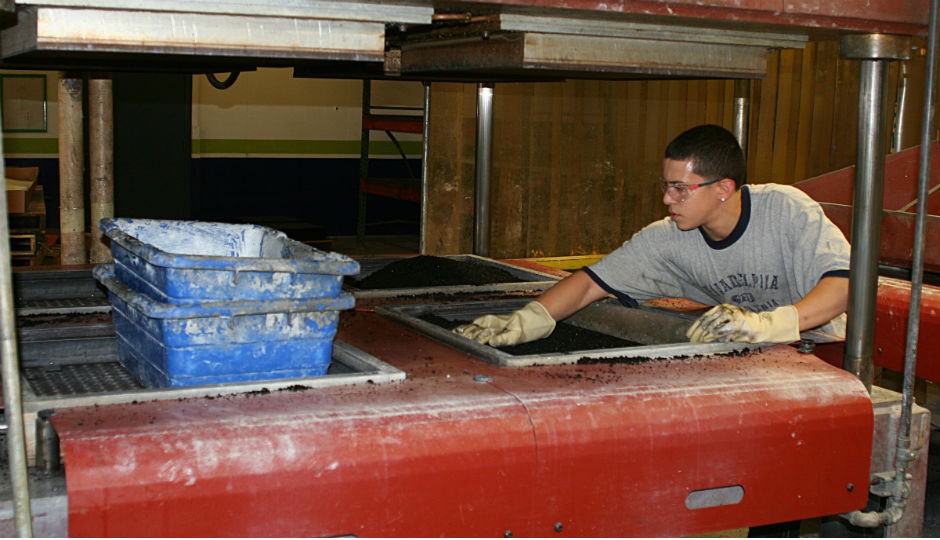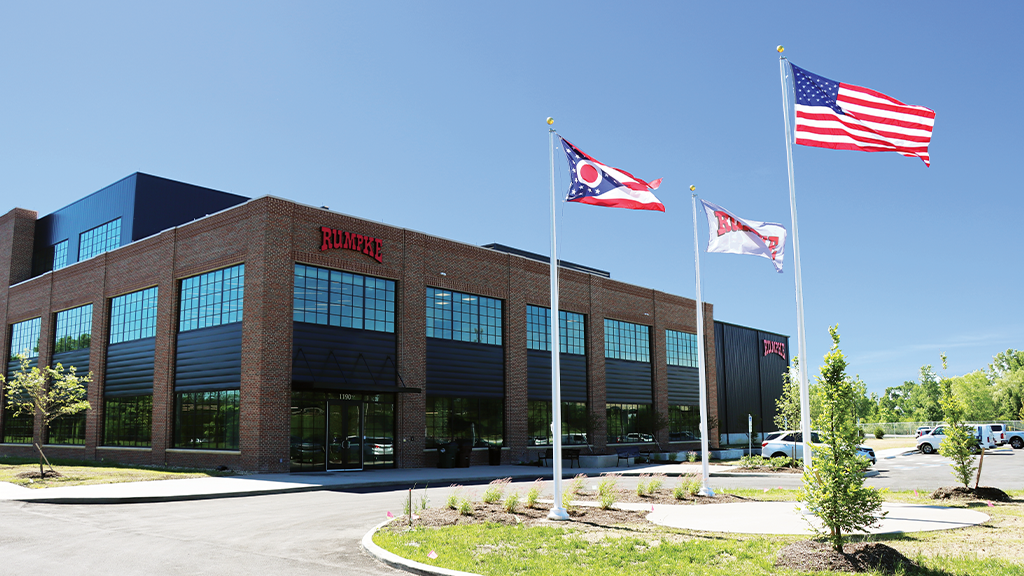A tire’s life beyond the road
High-tech automation allows recycler to lighten the load on operators

A tire comes into this world for just one purpose. It carries us from point “A” to point “B” and back again thousands of times. And then it’s over, sometimes with a bang, and other times just slowly and gradually. But at a tire’s end-of-life, then what? The world only needs so many tire swings, garden sculptures, and DIY craft projects. Where does all that tread go? Many of these “rubber souls” enjoy an afterlife well beyond their 50,000-mile warranty, thanks in large part to the resourcefulness of companies such as Ecore International (Ecore) out of Lancaster, Pennsylvania.
Ecore is one of only a handful of players in the recycled-rubber industry, but one of the first to bring recycled-rubber flooring out of the fitness centre and apply it toward more common, everyday surfaces.
Director of operations, John McFalls, makes the case for rubber’s versatility. “It has a lot of qualities: safety, sound absorption, resilience, and it lasts a very long time. From artificial turf and playground surfaces, flooring tiles, carpeting underlayment, basketball and tennis courts, to pavers, industrial gaskets and more, there’s almost no limit to what a tire can become. Ecore products made from recycled rubber can be found around the globe, and have even made their way further, onboard NASA’s space shuttle.”
More than 150 years ago, long before the automobile was even a glimmer on the horizon, Ecore got its start in cork.
“This is the oldest process we have,” McFalls says, referring to a stack of cork-filled burlap sacks. “These bales come right from the cork farm. What we do is we send them up into a machine that breaks it into fine particles, we take the moisture out and we’re left with granules.” In granular form, this cork can be mixed with a blend of adhesives and fused together for a wide range of purposes – much the same way rubber can.
To see where Ecore’s rubber products get their start, you’d have to visit the company’s processing plant in York, Pennsylvania. That’s where dirty, worn out tires turn into something with a lot more potential.
McFalls explains the process: “Basically we chop them up, process the material into finer and finer particles, we screen it, clean it, get the stones out, get the fibres out, and it’s all shipped to Lancaster.”
The rubber granules, or “rubber crumb,” when mixed with things like pigments and polymers and bonded together with heat, will take on almost any size and shape.
According to Ecore, it takes a lot of special recipes to get everything pulled back together just right, and efficient processing and accurate measuring of ingredients takes scales. At their tire recycling operation, you’ll find them everywhere. To keep things running smoothly, Ecore partners with Lancaster-based Garber Metrology to handle all of its calibration in the manufacturing process, from hand tools to scales. When it came time to source equipment that would help automate their tile-making process, Garber recommended Rice Lake.
One of the products Ecore produces are a wide range of floor tiles, which require a lot of flexibility and quick changeover from one product to the next. It’s physically demanding work with the potential for back injuries.
“This is the only department we have that’s really a manual labour process, where you’re actually physically touching the raw material, so we wanted to do everything we could to try and reduce that.”
To make the tiles, crumb rubber is mixed in small batches and portioned very precisely for each mould in a heated press. Using specialized recipes and different moulds, Ecore can make tiles of varying size, thickness, texture and layers. And by adding cutouts made separately on a waterjet cutter, they can even create pictures within a tile, for playgrounds and other custom needs.
McFalls references a pile of tiles stacked on a pallet, black on one side and light brown on the other.
“A product like this would be for some type of commercial flooring application. It might go into a health and fitness club, maybe into an office or entry way or something like that. You can purchase it in tiles like this, or much thinner tiles, or in a roll for a large room where you’d just roll the material out.”
Making rubber granules from recycled tires
Ecore’s tile-making process has always been physical by nature. Operators manually pull 40 pounds of rubber crumb from a bin into a bucket resting on a small floor scale. Surrounded by the heat of the presses, they repeatedly hoist each bucket up to chest level and pour the material into either side of a two-sided mixer.
A Rice Lake IQ plus 810 scale tallies the contents of the mixer for each of the additional ingredients, but that does little to ease the repeated physical demands of the job.
Once mixed, the contents are poured from the mixers into bins on the floor, which then need to be lifted onto another scale and portioned into single-tile batches. From there, the bins are carried to the press where the operator fills each mould. With all this lifting, movement, and potential for back injury, something had to be done.
With the help of Garber Metrology, Ecore has been able to upgrade and automate their process for the majority of its tile-making stations. They retrofitted existing mixers with better load cells and automated the flow of ingredients using the graphic display and wall-mount controls of Rice Lake’s 920i Controller. Rubber crumb and other ingredients are now dispensed automatically according to a stored recipe, and newly added spring lifts keep each operator’s movement at waist level.
“The pallet lift, as he loads it, keeps dropping, and when it’s empty it springs up to waist level again.” Another lift was installed in front of the mixers, raising the bins back up from the floor so they can slide them onto an adjacent bench scale for portioning.
“We really didn’t do it for efficiency. It was all ergonomics and safety, to stop operators from having to bend over and lift things up. “You’ve got the heat down here, the hot presses – anything we could do to make it a little easier. They love it.”



